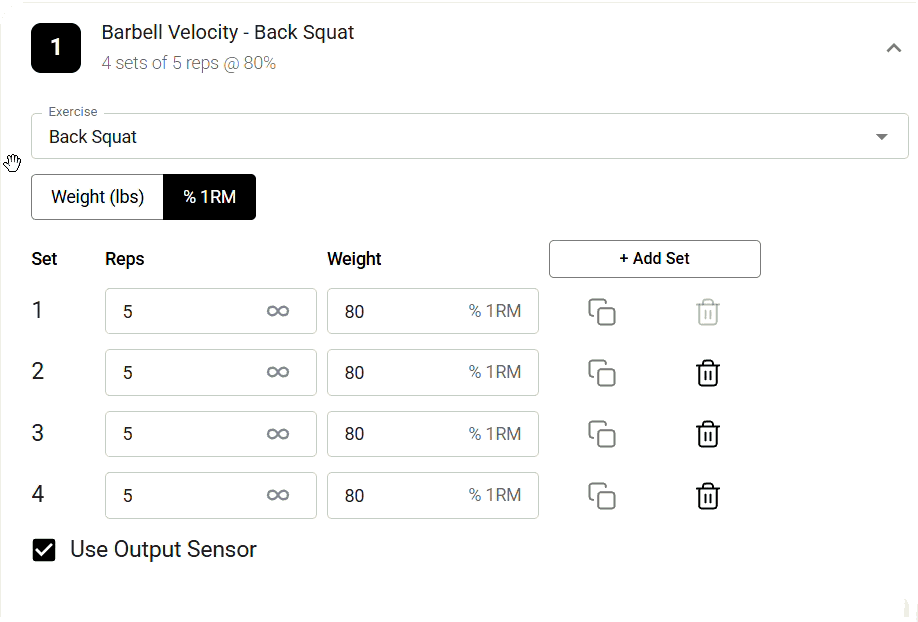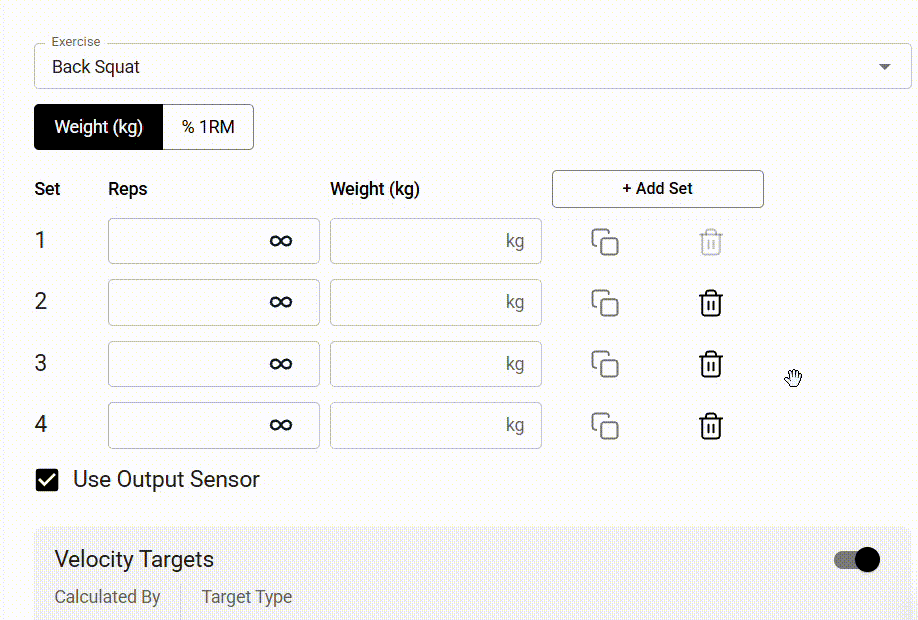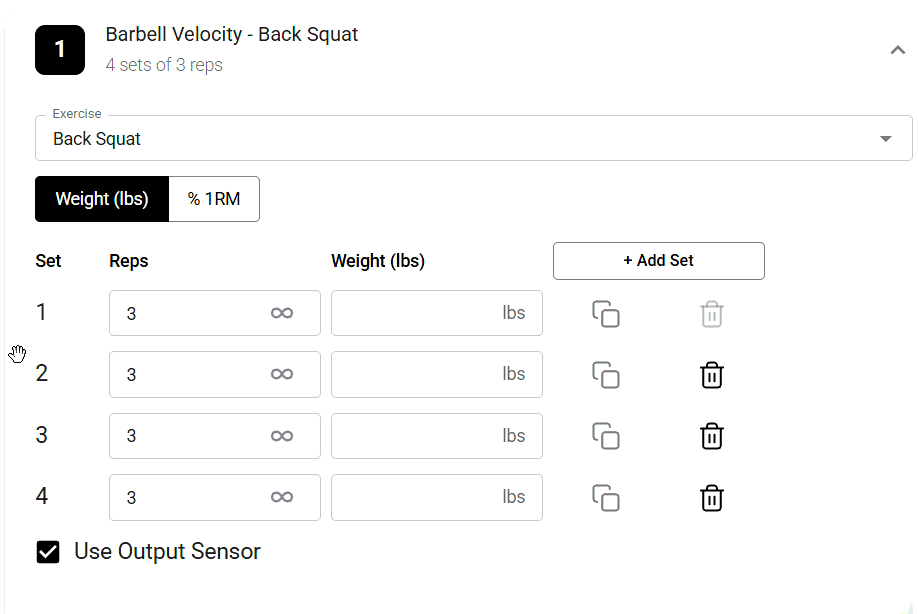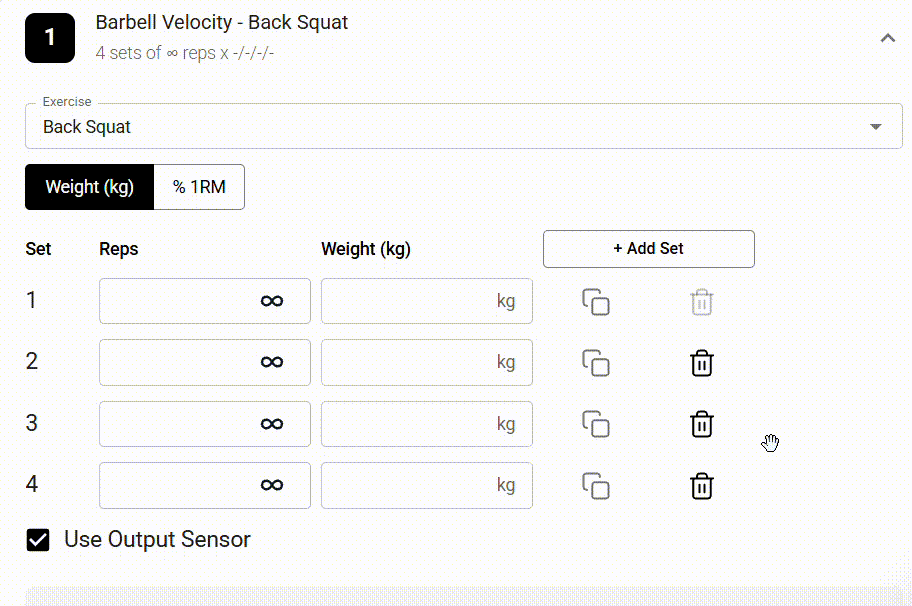BE THE FIRST TO GET PRODUCT UPDATES
Get notified about new features & special offers......
Velocity-Based Training (VBT) is more than just a tool for enhancing intent. It offers a flexible, evidence-based framework that can individualise, autoregulate, and optimise strength training based on how the athlete moves rather than what they lift.
Whether you're coaching elite athletes or general population clients, VBT can be integrated into your current methods to suit your environment and resources. There's no one-size-fits-all approach. Instead, VBT provides a toolkit for creating smarter, more adaptive programming.
In this article, we’ll explore four proven ways to programme using VBT, including practical examples and supporting research so you can decide which methods best suit your context.

Example: 4x5 @ 80% 1RM + Velocity Feedback
This is one of the most accessible entry points to VBT. Athletes follow a familiar prescription using a percentage of their 1-rep max (1RM), but with the added context of velocity feedback. Here, the intent is to move the load as quickly as possible to drive neural adaptations and optimise performance.
Pros:
Cons:
Research Insight:
Randell et al. (2011) found that velocity feedback during traditional strength training increased peak power output by up to 9% in elite rugby players [1].
Summary: Combining velocity feedback with %1RM programming enhances intent and supports long-term monitoring of readiness and quality, even if it lacks day-to-day load adjustments.

Example: 4x @ 0.6 m/s with 20% drop-off
In this method, a velocity threshold is set and the set ends when the athlete's rep velocity drops by a certain percentage (e.g., 20%) from the initial rep or the best rep depending on the coach’s preference. This ensures reps are performed with quality, avoiding unnecessary fatigue or reps outside the desired stimulus range.
Pros:
Cons:
Research Insight:
Pareja-Blanco et al. (2017) showed that using a 20% drop-off threshold in resistance training reduced fatigue and preserved neuromuscular function, while still leading to strength gains.
Summary: Drop-off training preserves rep quality and allows for precise targeting of strength, power, or endurance adaptations—without accumulating non-productive volume.

Example: 4x3 @ 0.3–0.60 m/s (Maximal Strength Zone)
Rather than prescribing %1RM, you assign a velocity range that corresponds to a specific adaptation. Athletes warm up to a load that hits the desired zone and adjust if they fall outside it. This method accounts for daily fluctuations in readiness and more accurately targets the physiological outcome.
Pros:
Cons:
Research Insight:
Jovanović and Flanagan (2014) demonstrated that barbell velocity correlates strongly with %1RM across multiple lifts, particularly in trained populations. This validates the use of velocity zones as a means of estimating and targeting specific strength qualities [2].
Summary: Velocity zones allow for autoregulated loading and training specificity without the need for constant 1RM testing.

Example: 4xAMRAP @ 0.40–0.60 m/s
Athletes perform as many reps as possible while staying within a defined velocity range. The load is selected so that the first rep sits near the top of the velocity zone (e.g., 0.55–0.6 m/s), giving room for natural velocity loss across reps.
The set ends once the athlete drops below the lower threshold (e.g., 0.40 m/s) for one or two consecutive reps. This method is similar to the method above, however rather than specifying a specific number of reps it allows for maximum effective volume whilst also autoregulating loads based on daily strength levels.
Pros:
Cons:
Research Insight:
Orange et al. (2022) demonstrated the effectiveness of AMRAP within a velocity zone to enhance power endurance and individualised work capacity in team sport athletes [3].
Summary: This approach enables volume autoregulation and performance monitoring in a single set, adapting naturally to athlete readiness.
Final Thoughts
Each of these VBT methods offers its own benefits depending on your training goal and athlete group. Whether you’re integrating VBT for the first time or refining a high-performance setup, consider:
Here’s a quick guide for matching methods to goals:

By programming with VBT, you unlock an intelligent, objective system that meets athletes where they are, while nudging them forward at exactly the right speed.
[1] L. Randell, T. Cronin, K. Keogh, J. Gill, and B. Pedersen, “Effect of instantaneous performance feedback during 6 weeks of velocity-based resistance training on sport-specific performance tests,” J. Strength Cond. Res., vol. 25, no. 1, pp. 87–93, Jan. 2011.
[2] F. Pareja-Blanco, R. Rodríguez-Rosell, J. Sánchez-Medina, A. Gorostiaga, and J. González-Badillo, “Effects of velocity loss during resistance training on athletic performance, strength gains and muscle adaptations,” Scand. J. Med. Sci. Sports, vol. 27, no. 7, pp. 724–735, 2017.
[3] M. Jovanović and E. P. Flanagan, “Researched applications of velocity based strength training,” J. Aust. Strength Cond., vol. 22, no. 2, pp. 58–69, 2014.
[4] S. Orange, J. Metcalfe, C. Liefeith, and G. B. Drury, “The effects of velocity-based training protocols on power and strength in team-sport athletes,” Int. J. Sports Physiol. Perform., vol. 17, no. 5, pp. 739–745, 2022.